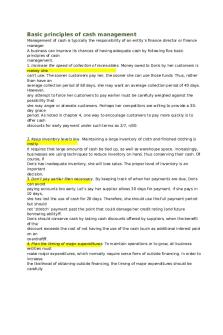Basic Principles OF Cytogenetics 1 PDF

| Title | Basic Principles OF Cytogenetics 1 |
|---|---|
| Course | Molecular Biology |
| Institution | Long Island University |
| Pages | 3 |
| File Size | 88.4 KB |
| File Type | |
| Total Downloads | 45 |
| Total Views | 190 |
Summary
Basic Principles OF Cytogenetics 1...
Description
One of the most important characteristics of eukaryotic cells is the differentiation of their nuclei. In it, the DNA molecules are surrounded by a nuclear membrane that separates them from the cytoplasm. The genetic information of the nucleus is condensed into chromosomes, evident in the division phase of the cell cycle. Therefore, structurally, the appearance of the nucleus depends on the moment of the cell cycle in which the cell is located, speaking of the interphase nucleus, when the cell is not in the division phase, and the mitotic nucleus, in which the chromosomes differentiate when the cell is dividing. Cytogenetics is the branch of genetics focused on the study of the structure, function and behavior of chromosomes. Human cytogenetics applies these studies to the diagnosis, prognosis and evolution of diseases with a genetic basis. But in order to delve into the subject, it is necessary to know some basic aspects such as the structure of chromosomes and their possible alterations. - THE CHROMOSOME A chromosome is an organized structure formed by the association of a linear DNA molecule, which carries part of the individual's genetic information and a set of proteins. The cytogenetic study is carried out in the metaphase period of the cell cycle, when the chromosome acquires the maximum degree of compaction and is perfectly visible and identifiable by light microscopy. In this phase of the metaphase chromosome, the structure and karyotype analysis is performed. - STRUCTURE OF THE METAPHASIC CHROMOSOME A chromosome is a more or less cylindrical structure found in identical number and morphology in all cells of individuals of the same species (Law of the numerical constancy of chromosomes). It has been proven that chromosomes are always individual entities, even when at the interface they are de-spiralized and it is impossible to differentiate them. Its size is between 0.2 and 50 μm in length and between 0.2 and 2 μm in width. We will study their morphology in greater depth and distinguish their structures: ● Chromatids: they are two linear and parallel filaments, exactly the same, united by protein complexes. Each chromatid is one of 2 identical DNA molecules resulting from replication. In mitosis the two chromatids separate, ensuring that both resulting daughter cells have the same genetic makeup as the original cell. ● Centromere or primary constriction: it is a narrowing that divides the chromosome into two arms. Their position is characteristic of each chromosome, and allows us to classify them into morphological types. It is a region rich in repetitive DNA (satellite DNA). On both sides of the centromere there is a protein structure that serves as an anchor for the microtubules of the mitotic spindle, called the kinetochore. ● Secondary constrictions: they are narrowing of the chromatids, shallower than the centromere. Some are related to the formation of the nucleolus (nucleolar organizers). ● Telomeres: are the ends of the chromatids. They are made up of thousands of repetitions of the same sequence and have important functions in the replication of the chromosome, in the interaction with the nuclear membrane, in the protection
against nucleases, in the structural stability of the chromosome, etc. They are also known to be related to cellular aging and some types of cancer. - TYPES OF CHROMOSOMES When the metaphase chromosomes are observed under the microscope, we observe elongated structures divided into 2 arms by the centromere. The length of each arm is marked by the position of the centromere, short arm (p) and long arm (q). Taking into account the length of both arms, the centromeric index (Ic) is defined ●
● ● ● ●
Ic = p 100 / p + q
Metacentric chromosomes: The centromere is located in the central region of the chromosome, the 2 arms are approximately equal (Ic = 50) . chromosomes Subacentric: The centromere is displaced from the center, there is a short and a long arm (Ic between 25 and 45). Acrocentric chromosomes: The centromere is close to one end, the short arm is very small (Ic...
Similar Free PDFs

1. Basic Principles of Economics
- 3 Pages

Basic Principles of Microbiology
- 6 Pages

Basic Principles of ultrasound
- 38 Pages

Basic Principles OF Fascism
- 5 Pages

Basic Principles of Heredity
- 23 Pages

BASIC PRINCIPLES OF TAXATION
- 46 Pages

2-Basic Principles of Heredity
- 23 Pages

Basic Principles of Power Electronics
- 312 Pages

BASIC DOPPLER PRINCIPLES
- 22 Pages

1 Basic of knitting
- 3 Pages
Popular Institutions
- Tinajero National High School - Annex
- Politeknik Caltex Riau
- Yokohama City University
- SGT University
- University of Al-Qadisiyah
- Divine Word College of Vigan
- Techniek College Rotterdam
- Universidade de Santiago
- Universiti Teknologi MARA Cawangan Johor Kampus Pasir Gudang
- Poltekkes Kemenkes Yogyakarta
- Baguio City National High School
- Colegio san marcos
- preparatoria uno
- Centro de Bachillerato Tecnológico Industrial y de Servicios No. 107
- Dalian Maritime University
- Quang Trung Secondary School
- Colegio Tecnológico en Informática
- Corporación Regional de Educación Superior
- Grupo CEDVA
- Dar Al Uloom University
- Centro de Estudios Preuniversitarios de la Universidad Nacional de Ingeniería
- 上智大学
- Aakash International School, Nuna Majara
- San Felipe Neri Catholic School
- Kang Chiao International School - New Taipei City
- Misamis Occidental National High School
- Institución Educativa Escuela Normal Juan Ladrilleros
- Kolehiyo ng Pantukan
- Batanes State College
- Instituto Continental
- Sekolah Menengah Kejuruan Kesehatan Kaltara (Tarakan)
- Colegio de La Inmaculada Concepcion - Cebu





